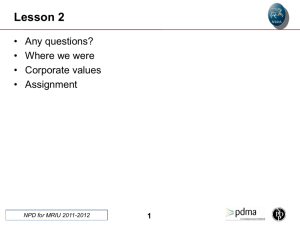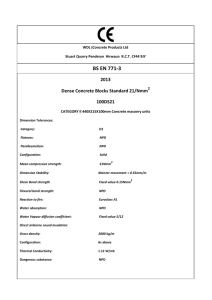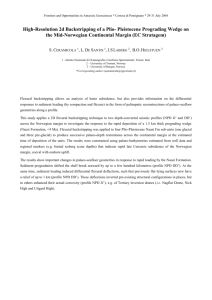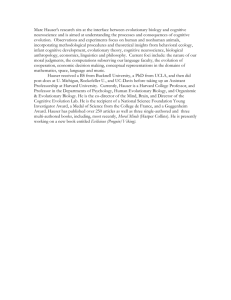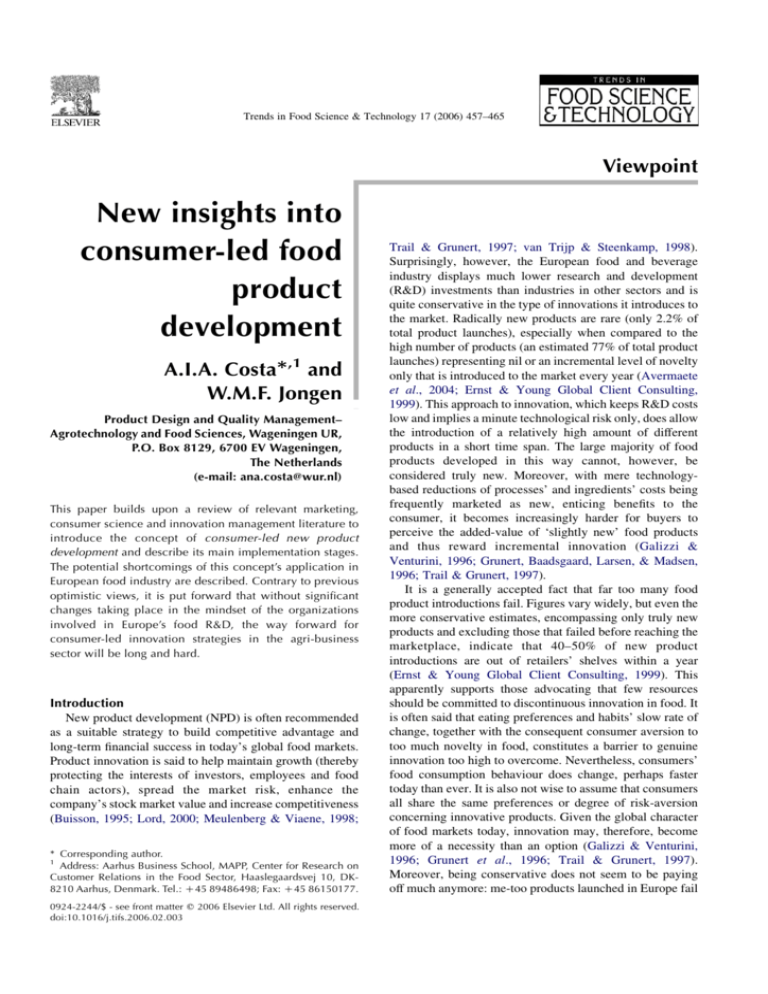
Trends in Food Science & Technology 17 (2006) 457–465
Viewpoint
New insights into
consumer-led food
product
development
A.I.A. Costa*,1 and
W.M.F. Jongen
&
Product Design and Quality Management–
Agrotechnology and Food Sciences, Wageningen UR,
P.O. Box 8129, 6700 EV Wageningen,
The Netherlands
(e-mail: ana.costa@wur.nl)
This paper builds upon a review of relevant marketing,
consumer science and innovation management literature to
introduce the concept of consumer-led new product
development and describe its main implementation stages.
The potential shortcomings of this concept’s application in
European food industry are described. Contrary to previous
optimistic views, it is put forward that without significant
changes taking place in the mindset of the organizations
involved in Europe’s food R&D, the way forward for
consumer-led innovation strategies in the agri-business
sector will be long and hard.
Introduction
New product development (NPD) is often recommended
as a suitable strategy to build competitive advantage and
long-term financial success in today’s global food markets.
Product innovation is said to help maintain growth (thereby
protecting the interests of investors, employees and food
chain actors), spread the market risk, enhance the
company’s stock market value and increase competitiveness
(Buisson, 1995; Lord, 2000; Meulenberg & Viaene, 1998;
* Corresponding author.
1
Address: Aarhus Business School, MAPP, Center for Research on
Customer Relations in the Food Sector, Haaslegaardsvej 10, DK8210 Aarhus, Denmark. Tel.: C45 89486498; Fax: C45 86150177.
0924-2244/$ - see front matter q 2006 Elsevier Ltd. All rights reserved.
doi:10.1016/j.tifs.2006.02.003
Trail & Grunert, 1997; van Trijp & Steenkamp, 1998).
Surprisingly, however, the European food and beverage
industry displays much lower research and development
(R&D) investments than industries in other sectors and is
quite conservative in the type of innovations it introduces to
the market. Radically new products are rare (only 2.2% of
total product launches), especially when compared to the
high number of products (an estimated 77% of total product
launches) representing nil or an incremental level of novelty
only that is introduced to the market every year (Avermaete
et al., 2004; Ernst & Young Global Client Consulting,
1999). This approach to innovation, which keeps R&D costs
low and implies a minute technological risk only, does allow
the introduction of a relatively high amount of different
products in a short time span. The large majority of food
products developed in this way cannot, however, be
considered truly new. Moreover, with mere technologybased reductions of processes’ and ingredients’ costs being
frequently marketed as new, enticing benefits to the
consumer, it becomes increasingly harder for buyers to
perceive the added-value of ‘slightly new’ food products
and thus reward incremental innovation (Galizzi &
Venturini, 1996; Grunert, Baadsgaard, Larsen, & Madsen,
1996; Trail & Grunert, 1997).
It is a generally accepted fact that far too many food
product introductions fail. Figures vary widely, but even the
more conservative estimates, encompassing only truly new
products and excluding those that failed before reaching the
marketplace, indicate that 40–50% of new product
introductions are out of retailers’ shelves within a year
(Ernst & Young Global Client Consulting, 1999). This
apparently supports those advocating that few resources
should be committed to discontinuous innovation in food. It
is often said that eating preferences and habits’ slow rate of
change, together with the consequent consumer aversion to
too much novelty in food, constitutes a barrier to genuine
innovation too high to overcome. Nevertheless, consumers’
food consumption behaviour does change, perhaps faster
today than ever. It is also not wise to assume that consumers
all share the same preferences or degree of risk-aversion
concerning innovative products. Given the global character
of food markets today, innovation may, therefore, become
more of a necessity than an option (Galizzi & Venturini,
1996; Grunert et al., 1996; Trail & Grunert, 1997).
Moreover, being conservative does not seem to be paying
off much anymore: me-too products launched in Europe fail
458
A. I. A. Costa, W. M. F. Jongen / Trends in Food Science & Technology 17 (2006) 457–465
(on country average) 18% more often than line extensions
and about 24% more than truly new products (Ernst &
Young Global Client Consulting, 1999).
Consumer-led product development was introduced in
the early 1990s as a market-oriented innovation concept
concerning the use of consumers’ current and future needs
and its determinants in the development of new products
with true added value (Urban & Hauser, 1993). It has been
since repeatedly advocated by several marketing and food
technology experts (Lord, 2000; van Trijp & Steenkamp,
1998), but little has been done to consolidate its theoretical
foundations and establish concrete methodological guidelines for its practical implementation. To our knowledge,
only two applications of consumer-led NPD within the food
industry have been described so far (Grunert & Valli, 2002;
Jaeger, Rossiter, Wismer, & Harker, 2003), each following
its own methodological approach. Additionally, empirical
or case-based studies analysing the advantages and
disadvantages of this innovation strategy vis-à-vis the
conventional NPD practices within the food industry have
not yet been reported.
This article builds upon a review of the relevant
marketing, consumer science and innovation management
literature to describe the economic background and the
theoretical foundations that brought about the concept of
consumer-led new product development. Next, the key
stages of the concept’s practical implementation and the
potential shortcomings of its application within the food
sector are described. Additionally, an attempt is made to
forecast the future of consumer-led food product development in Europe in the current circumstances and to highlight
some of the areas in which more research is necessary to
ensure its prosperity.
The challenges of today’s global food markets
Socio-economic and technological developments
occurring during the last decades in Western society
have triggered the need for a shift of the agricultural and
food industry sectors’ orientation from production to
market. The fact that food markets have become buyer
markets rather than seller markets has several explanations (Grunert et al., 1996; Meulenberg & Viaene,
1998). From the economic perspective, the increase of
disposable income and the decrease in population growth
resulted in the deceleration of the demand for food.
Meanwhile, the scientific and technological developments
of the last half-century gave rise to global-scale food
production and distribution, making an ever-diverse and
ever-increasing food supply almost permanently available
everywhere. This imbalance between supply and demand
decreased the importance of availability and price as
determinants of food purchase and increased the relative
importance of consumers’ choice criteria (Meulenberg &
Viaene, 1998; van Trijp & Steenkamp, 1998). Nowadays,
most Western consumers can buy exactly what they want
to eat, instead of only what is readily available or
affordable, and have, therefore, become the driving
element of the food chain.
Due to the significant changes in life-styles and values
taken place in the last 50 years, the nature of food choice
itself has been transformed. Smaller, higher-educated
families, in which both adults work full-time, and
single-person or single-parent households have triggered
a quiet revolution that is gradually doing away with
conventional eating patterns. The growing importance of
values such as quality of life, well-being or protect the
planet’s environment is also exerting influence on the way
consumers perceive and evaluate foods and production
systems, thereby increasingly determining choice (Meulenberg & Viaene, 1998). Western consumers are likewise
demanding more and better information about the food
they eat and how it is produced. They are increasingly
aware of the interdependence between food production,
food consumption, their own health and that of the
environment. This awareness, together with an abundant
and diversified supply, has made consumers highly critical
of, and demanding about, food products’ quality and
safety (Earle, 1997; van Trijp & Steenkamp, 1998).
Finally, consumers are more heterogeneous and whimsical
than ever, which makes their food choice harder to
understand and predict (Grunert et al., 1996; Linnemann,
Meerdink, Meulenberg, & Jongen, 1999). To gain a better
knowledge of what consumers want, how their needs
change and how such changes can be promptly addressed
is consequently becoming not only a factor of success for
the agri-food businesses, but ultimately also one of mere
survival. Companies who are able to uncover (or, better
yet, anticipate) demand, deliver against it and communicate this effectively to consumers increase highly their
chances of survival and success in the marketplace (Kohli
& Jaworski, 1990; Urban & Hauser, 1993). This is
particularly true in the context of today’s global food
markets, in which manufacturers and distributors seek to
produce and sell foods to both familiar and unfamiliar
customers in the midst of world-wide competition.
Public health, environmental and sustainability policies
may also bring about the need to influence consumer’s
food choice. This influence can be exerted either by
regulating processes and products (i.e. affecting availability) or by educating consumers about the relation
between food consumption, health and the environment
(i.e. changing the relative importance of choice criteria).
In any case, the food chain will be affected, either directly
or indirectly, and the development of an effective means
of communication between people and organisations
becomes crucial in being able to cope with policy change
(Best, 1991; Meulenberg & Viaene, 1998). If consumers
cannot grasp the need to adjust their behaviour, as well as
the benefits to be gained by such an adjustment, they will
not accept change, let alone behave according to the
policy-makers’ expectations. Similarly, for innovative
A. I. A. Costa, W. M. F. Jongen / Trends in Food Science & Technology 17 (2006) 457–465
technologies to be successfully applied in food production
they must be, first and most, analysed in terms of
perceived consumer value. Carelessly pushing them
forward simply because they might be highly advantageous for the food chain’s actors can, in spite of all
efforts, do more harm than good (Best, 1991; Fuller, 1994;
Meulenberg & Viaene, 1998).
Market-orientation and consumer-led new product
development
Agriculture and food enterprises clearly need to
develop further their understanding of the markets in
which they operate and skilfully apply this knowledge in
the creation of competitive advantage. The most adequate
way to achieve this is probably through the implementation of the market-orientation concept (Grunert et al.,
1996). Market-oriented companies are those which have
committed themselves to the continuous generation and
internal dissemination of market intelligence relevant to
the current and future needs of their customers, as well as
to the continuous improvement of their responsiveness to
such needs (Kohli & Jaworski, 1990). Although a positive
relationship between market-orientation and business
performance has been established for several types of
industries (Avlonitis & Gounaris, 1997; Han, Kim, &
Srivastava, 1998; Slater & Narver, 2000), not much is
known about the level of market-orientation of European
food companies and how it influences their performance.
One could expect the current scenario of high market
instability, increasing competitiveness, slowing economy
and modest technological development to be rather
favourable to a market-oriented approach (Kohli &
Jaworski, 1990). Nevertheless, few studies addressing
this topic indicate that the generation of consumer
intelligence by the food industry, a necessary but not
sufficient condition for market-orientation, remains very
scarce and mostly accidental. In practice, most food
companies, with the probable exception of some large
multinationals, rely on retailers to obtain information
about their end-users. This leads to the assumption that
truly market-oriented food companies are still rare in
Europe (Avermaete et al., 2004; Harmsen, 1994;
Meulenber & Viaene, 1998; Trail & Grunert, 1997).
Studies in innovation management have looked closely
at the relationship between market-orientation and new
product development (NPD), suggesting that these
organisational processes could greatly benefit from each
other (Grunert et al., 1996; Kok, Hillebrand, & Biemans,
2001). On one hand, it has been sufficiently demonstrated
that market-orientation is a critical factor in successful
product development and innovation processes (AtuaheneGima, 1995; Cooper & Kleinschimdt, 1994; Lukas &
Ferrel, 2000; Wind & Mahajan, 1997). On the other hand,
it is rather straightforward to conclude that the continuous
adaptation of a company’s products and services to the
market (i.e. NPD) is a pertinent way of formulating the
459
market-orientation concept. NPD can be seen as an
organisational process in which information about the
market and its actors is gathered, diffused, assimilated and
returned in the shape of a new product or service.
Consequently, a market-oriented approach to product
development implies a sound understanding of:
1. The fact that both technical knowledge and market
information are necessary to run effective product
development processes;
2. The way market information can be gathered,
disseminated and combined with technical knowledge
to develop successful products (Grunet et al., 1996).
It is also thought that the implementation of marketorientation in innovation and NPD processes can be a
crucial step in leading the remainder of the organisation to a
more market-oriented conduct (Kok et al., 2001).
The concept of consumer-led new product development
can be viewed as a market-oriented innovation strategy
developed specifically for the manufacturers of consumer
goods, as it focuses on the share of market intelligence
pertaining to the end-users. It is an integrated concept
concerning the application of consumers’ current and future
needs, and its determinants, in the development of
innovative products with true added value (Grunert et al.,
1996; Lord, 2000; Urban & Hauser, 1993; van Trijp &
Steenkamp, 1998). Its main pillars are:
– Consumer needs should be the starting point of NPD
processes;
– NPD should aim at the fulfilment of consumer needs and
the realisation of consumer value rather than at the
development of products or enabling technologies per se;
– Given that increased sales and satisfactory returns on
investment can only be achieved if consumer needs are
effectively identified and satisfied, the measure of
success of a NPD process should be the degree of fit
between the new product and the needs of the targeted
consumers.
The key stages in the formulation of the consumer-led
NPD concept follow closely a market-oriented approach:
need identification, idea development to address the need,
product development to substantiate the idea and the
product’s market introduction to communicate the
fulfilment of a need (Urban & Hauser, 1993) (Fig. 1).
An effective ability to translate subjective needs (e.g.
healthy or convenient) into objective product specifications is essential for the realisation of the satisfaction of
consumer needs through the development of a new
product. Concurrently, marketing strategies communicating the existence of a new or improved product which
satisfies consumer needs in a distinctive and superior way
must be conceived. It is thought that such a consumer-led
approach to product development can greatly increase the
likelihood of success of innovation processes (Dahan &
A. I. A. Costa, W. M. F. Jongen / Trends in Food Science & Technology 17 (2006) 457–465
460
Consumer research
R&D/Production
Opportunity identification
Market definition
Idea generation
Consumer
needs
Product
concept
Go
No
Product design
Con sumer needs
Sales forecasts
Product positioning Engineering
Segmentation
Marketing mix
Product
and image
No
Go
Testing
Advertising and product testing
Pre-test and pre-launch forecasting
Test marketing
Go
No
Market communication
Introduction
Fig. 1. The consumer-led new product development concept.
Hauser, 2002; Grunert et al., 1996; Urban & Hauser,
1993; van Trijp & Steenkamp, 1998; Wind & Mahajan,
1997).
If one accepts that the European food industry currently
possesses a low degree of market-orientation, the benefits of
introducing consumer-led NPD become obvious. Having in
mind the socio-economic constraints earlier described, it is
relatively simple to conclude that European food production
chains must increasingly rely on the industry’s ability to
continuously develop innovative and differentiated products
with added consumer value. Therefore, any approach that
promotes the efficiency and effectiveness of product
innovation processes is welcomed (Grunert et al., 1996;
Meulenberg & Viaene, 1998; van Trijp & Steenkamp,
1998). Moreover, seeing that consumer-led NPD is a
tangible way of putting market-orientation into practice,
its implementation should lead to a better financial
performance of the agri-business sector as a whole.
Key stages in a consumer-led NPD process
Fig. 2 depicts the key stages of a consumer-led NPD
process. The opportunity identification stage aims at
defining the target markets in which management expects
NPD efforts to be profitable and generating product ideas
which can successfully compete in these markets. At this
stage, supported by a thorough understanding of its own and
the competitors’ core competences and unique strengths,
companies should conduct a strategic assessment of which
technological platforms might provide a solid basis for
NPD. If, given the outcome of such an assessment,
potentially attractive markets and ideas can be found, the
decision to initiate the development process can take place
(Dahan & Hauser, 2002; Robinson, 2000; Urban & Hauser,
1993; van Trijp & Steenkamp, 1998).
Launch planning
Tracking the launch
Go
No
Life-cycle management
Market response analysis
Competitive monitoring & defence
Innovation at maturity
Reposition
Fig. 2. The consumer-led new product development process
(adapted from Urban & Hauser, 1993).
The design stage seeks to identify the key consumer
benefits the new product is to provide, as well as the
positioning of these benefits via-à-vis the competition. It is
thus at this stage that the development of the physical
product, the correspondent marketing strategy and the
service policy takes place (Urban & Hauser, 1993; van
Trijp & Steenkamp, 1998).
Fig. 3 depicts the main elements of the product design
stage. The strategic information about the target consumers
collected during the opportunity identification stage serves
as primary input for the first design element—opportunity
definition. At this point, the potentially rewarding ideas
selected earlier are submitted to the target consumers’
evaluation. Such an early evaluation is crucial since it
allows for an assessment of the market potential of the
selected ideas to take place before any considerable funds
are committed to the NPD process. Both qualitative and
quantitative consumer research are undertaken at this point.
Qualitative research methods are usually employed first to
identify relevant issues which may need further investigation, while quantitative methods are used at a later time to
establish the expected benefits and their relative importance
in a more precise manner (Urban & Hauser, 1993; van Trijp
& Steenkamp, 1998). Next, a list of benefits and their
relative importance to consumers is conveyed into a
A. I. A. Costa, W. M. F. Jongen / Trends in Food Science & Technology 17 (2006) 457–465
Voice of the Consumer
Consumer Research
1. Qualitative, to identify issues
2. Quantitative, to supply input for
the modelling of consumer aspects
Summary of consumer aspects
Perception
Product
Preference
Segments
461
Voice of the Company
Opportunity Definition
Opportunity Refinement
•
•
•
•
Marketing
R&D
Engineering
Production
Choice
“What-if” forecasts
• Aggregate individuals
• Awareness and availability
Opportunity Evaluation
Fig. 3. The product design stage (adapted from Urban & Hauser, 1993).
refinement phase, in which the new product starts to take
shape. This is achieved through a careful analysis of the
relationships between consumer perceptions, preferences
and choices, on one hand, and the product’s technical
features on the other. Underlying this analysis is a
conceptual model of consumer behaviour in which
preferences are formed based on the perceptions of the
products’ features and lead, in turn, to choices contingent
upon price and availability (Tybout & Hauser, 1981; Urban
& Hauser, 1993; van Trijp & Steenkamp, 1998). Finally, if
the refinement phase was completed successfully, i.e. if it
was possible to design a new product that could potentially
fulfil consumer needs in a superior and unique way, an
evaluation of the design takes place—opportunity evaluation. This evaluation consists of forecasting sales for the
designed product based on the aggregation of the
probabilities of individual consumers’ preferences and
choices. If the estimated market performance complies
with expectations, further development and testing of both
the product and its marketing strategy can occur.
Once the testing of the new product and its marketing
strategy has been successfully concluded (Fig. 2), the
market introduction of the new product takes place. The
monitoring of the target consumers’ and the competitors’
reactions to the new product’s introduction, which might
lead to adjustments in the product and the marketing
strategy, constitutes the final stage of the NPD process, the
so-called life-cycle management (Urban & Hauser, 1993).
Limitations to the application of consumer-led
NPD in European food industry
There are many reasons why food companies decide to
develop and market new products. This decision is often
associated with changes occurring in the food chain
and/or its environment which are not necessarily related to
consumers’ needs (Best, 1991; Fuller, 1994). Upstream
changes in the production chain, like supplier, package or
ingredient modifications, typically imply product and
process reformulations and constitute, thus, a common
motive for food companies to initiate product development. But downstream changes such as alterations in the
distribution channels, introduction of competing products
or internationalisation may also bring about NPD
activities. Finally, developments in the chain’s environment, like the availability of new technologies or
restrictions imposed by governmental and supra-governmental legislation, can trigger innovation efforts too. All
these cases are prototypical of the so-called reactive
approach to NPD, in which food companies try to market
what was developed through advertising and other
marketing efforts rather than developing what consumers
wanted in the first place (Buisson, 1995; Urban & Hauser,
1993). On the other hand, it has by now become clear that
the continuous collection and assimilation of suitable
information about the consumers’ views and needs, since
the very beginning of development until the market
introduction stage and beyond, is an essential feature of
462
A. I. A. Costa, W. M. F. Jongen / Trends in Food Science & Technology 17 (2006) 457–465
consumer-led NPD. This feature, along with the fact that
the concept itself implies taking consumer needs as the
starting point of product innovation efforts, makes of it
the quintessential example of a proactive approach to
NPD (Urban & Hauser, 1993). It would seem then quite
obvious to conclude that, given the current socioeconomic background against which the European food
industry is set, proactive strategies for product innovation
should be more successful than reactive ones. Yet, there is
a major downsize to this reasoning, which is the fact that
there are no published empirical or case-studies demonstrating that proactive strategies are significantly more
successful than their reactive counterparts in the context
of food industry. Being as it is, the motivation to adopt a
proactive approach to food innovation, such as consumerled NPD, relies solely on management’s strategic vision
and a leap of faith. It is, therefore, imperative for
researchers in food innovation management to concentrate
their efforts on clarifying whether or not (and in which
circumstances) consumer-led NPD can lead to products
that are more successful in the marketplace than those
developed through more conventional innovation
strategies.
Understanding consumer needs and reacting effectively
to them is believed by many to be one of the most
important correlates of product development success
(Cooper & Kleinschmidt, 1994; Grunert et al., 1996;
Saguy & Moskowitz, 1999; Urban & Hauser, 1993).
There are those, however, who question the value of
consumer focus in NPD. It has been stated that consumerled development activities, by following closely consumer
needs, encourage incremental innovation in detriment of
the development of truly new products. The main
argument sustaining this view is that consumers cannot
be expected to provide needs about products or
technologies which are yet unknown to them (AtuaheneGima, 1995; Ortt & Schoormans, 1993; van Trijp &
Schifferstein, 1995; Wind and Mahajan, 1997). In line
with this argument, several methodologies, such as
consumer-idealised design (Ciccantelli & Magidson,
1993), problem and lead-users design (Ortt & Schoormans, 1993; von Hippel, 1986), beta-testing (Kaulio,
1998) and information-acceleration (approach which
places consumers in future technological scenarios)
(Urban & Hauser, 1993), have been developed to
overcome this obstacle. More recently, researchers
begun to explore the potential of image-based, webbased and virtual reality technologies to obtain better,
real-time consumer information and involvement in NPD
processes (Dahan & Hauser, 2002; Wind & Mahajan,
1997). It would be advisable also for those active in food
innovation research to explore the ability of these
technological developments to improve the quality of
the consumer intelligence obtained, as well as the cost
efficiency of consumer research methods.
One of the major and most obvious gaps in consumerled food product development is the lack of clear and
concrete guidelines for its effective implementation in
everyday company practices. This deficiency is felt mostly
(but not uniquely) at the early phases of the development
process—opportunity identification and opportunity definition—which are simultaneously the less structured and
the more determinant for the success of new products
(Nijssen & Frambach, 2000; Nijssen & Lieshout, 1995).
Quite suitably, these phases have been named the fuzzyfront end of consumer-led NPD (Dahan & Hauser, 2002).
It is at this fuzzy-front end that the integration of the
appropriate intelligence regarding the market, the competitors and consumers, which is essential for companies to
be able to successfully match their core competences with
demand, must take place (Cooper & Kleinschmidt, 1994;
Grunert et al., 1996; Lord, 2000; Robinson, 2000; Urban
& Hauser, 1993). Nevertheless, it was only very recently
that efforts to compile and test the applicability and
validity of the methods and tools associated with the
fuzzy-front end, in the context of consumer-led food
product design, have taken place (Costa, 2003; van Kleef,
van Trijp, & Luning, 2005). Efforts to extend this line of
research as to encompass methods and tools associated
with the later stages of consumer-led NPD should be
envisaged.
Finally, a somewhat sequential (rather than concurrent,
overlapping or iterative) nature of consumer-led NPD has
been pointed out as a conceptual weakness and a
considerable obstacle to its application in the food
industry (Buisson, 1995; Fuller, 1994; Stewart-Knox &
Mitchell, 2003; van Trijp & Steenkamp, 1998). Nevertheless, attempts have been made to improve the realism
and effectiveness of consumer-led NPD, such as with the
funnel (Wheelright & Clark, 1992) and the spiral
approaches (Cusumano & Selby, 1995). Both these
approaches start with a broad range of ideas from several
sources that are later winnowed to a few high-potential
concepts, some of which will, in turn, be ultimately
developed and launched. The underlying assumption is
that it is less expensive (and more effective) to screen
many alternative concepts at an early stage than to modify
one product during testing and pre-launch. The latest and
most holistic approach has been suggested by Dahan and
Hauser (2002)—the end-to-end NPD process—with the
aim of developing new product platforms within a prespecified market environment. This concept combines the
advantages of the stage-gate approach (Rudolph, 1995), in
which developers must justify their selection of the most
promising option at each NPD stage, with those of the
funnel approach. The end-to-end approach integrates the
different development stages and takes into account
environmental influences, such as those related to the
supply chain or human resources’ expertise, as well as
trade-offs between time-to-market, customer satisfaction
and costs. Whether these holistic approaches could also be
A. I. A. Costa, W. M. F. Jongen / Trends in Food Science & Technology 17 (2006) 457–465
successfully applied in the context of food product
development remains to be demonstrate, thereby posing
a very interesting challenge to researchers in the area of
food innovation management.
The key issue of effective knowledge and effort
integration in food innovation
A structural weakness of consumer-led NPD in what
concerns its potential application in the food industry is that
this concept does not explicitly address the role of chain
actors other than consumers in product innovation management. Looking at the markets in which food manufacturers
operate today this hardly seems realistic. Several studies
point out that European food companies do involve, at least
on an informal basis, retailers and suppliers in their product
development processes. Furthermore, it is reasonable to
expect that the vertical integration of product innovation
management will greatly increase the chances of new
product success in the marketplace (Ernst & Young Global
Client Consulting, 1999; Kristensen, Ostergaard, & Juhl,
1998; Stewart-Knox & Mitchell, 2003; Trail & Grunert,
1997). The establishment of methods for an effective, chainwide integration of product development activities is,
therefore, an area where considerable improvement could
be made, not only for the benefit of the implementation of
consumer-led strategies but also of food innovation management as a whole.
Unfortunately, difficulties in properly coordinating and
integrating activities in food product development are, by
no means, limited to operations at the chain level. It is
frequently heard among researchers and practitioners of
food R&D that there is very little motivation to move
away from their technology-driven environment and start
paying more attention to consumer needs and proactive
innovation strategies. Such issues are frequently seen as
more of a marketing concern than anything else.
Consequently, marketing and consumer researchers active
in the area of food innovation management who openly
advocate the benefits of changing to a more marketoriented approach in food R&D are often met with
considerable scepticism. What they must also understand
is that food science academia and R&D practitioners have
not been, so far, often required (or encouraged) to think
about how to design and sell an augmented product as the
consumer demands it. Perhaps, a wiser approach is to start
by taking less extreme views on both sides of the issue
and look for ways in which the market-pull and the
technology-push can benefit from each other. For instance,
a food company can make the decision to commit a share
of its resources to the investigation of the market potential
of its innovative product ideas, irrespective of where they
come from, at the earliest stage possible. Or, instead,
decide that consumer research in the context of market
opportunity identification must already take the
463
company’s core technological competences sufficiently
into account (Kok et al., 2001).
On the other hand, there is also a tendency among
marketing scholars and practitioners active in the agribusiness area to overlook the ingenuity and innovation
potential of many of those specialised in exact sciences or
engineering. What cannot be overstated is the fact that those
employed in R&D and production are fundamental
providers of a company’s enabling technologies and core
competences. Given that they are also the ones who will
ultimately create the core product, their expertise and buy-in
is vital to the success of any market-oriented innovation
effort (Urban & Hauser, 1993; van Trijp & Schifferstein,
1995; van Trijp & Steenkamp, 1998). Reinforcing this view
is the recent development of computer and web-based
interface design tools which, instead of conveying the voice
of the consumer from marketing to R&D as in standard NPD
practices, enable technical personnel to contact directly with
consumers throughout the whole design process (Dahan &
Hauser, 2002).
Ultimately, the sustained practice of consumer-led food
product development implies that an effective integration of
the knowledge and efforts of management, marketing, R&D
and production has been achieved. This is a notoriously
difficult feat in any type of industrial organisation, but one
upon which the success of new products in a global
marketplace is crucially dependent (Dahan & Hauser, 2002;
Griffin & Hauser, 1996; Urban & Hauser, 1993; van Trijp &
Steenkamp, 1998).
Final remarks
Contrary to previous, more optimistic visions, this
viewpoint suggests that without significant changes taking
place in the mindset of the organizations involved in
Europe’s food R&D, the way forward for consumer-led
innovation strategies in the agri-business sector will be long
and hard. In this context, we have highlighted what we
perceive to be the three major obstacles to the implementation of this kind of innovation strategies:
(1) The lack of concrete guidelines for the effective
implementation of consumer-led food product development in everyday industry practices;
(2) The sequential nature of consumer-led NPD, in a clear
contrast with the reality experienced by R&D practitioners in their activities;
(3) The lack of intra- and inter-organisational coordination
or integration of R&D and Marketing’s research
activities and know-how.
Nevertheless, the removal of the first two obstacles will
be meaningless unless a serious effort is made to break
down the barriers to intra- and inter-organisational
cooperation within food supply chains. The time has
come to do away with the clan mentality prevailing in the
European agri-business and food-related research by
464
A. I. A. Costa, W. M. F. Jongen / Trends in Food Science & Technology 17 (2006) 457–465
encouraging cross-functional communication, multidisciplinary team work and the development of a common
language for innovation that truly focuses on consumer
needs without neglecting technological know-how. Or
otherwise, we might just as well missed the marketorientation boat altogether.
Acknowledgements
The research leading to this article was carried out with
the financial support of the Portuguese Foundation for
Science and Technology, under the Program PRAXIS
XXI.
References
Atuahene-Gima, K. (1995). An exploratory analysis of the impact of
market orientation on new product performance: A contingency
approach. Journal of Product Innovation Management, 12, 275–
293.
Avermaete, T., Viaene, J., Morgan, E. J., with Pitts, E., Crawford, N.,
& Mahon, D (2004). Determinants of product and process
innovation in small food manufacturing firms. Trends in Food
Science and Technology, 15, 474–483.
Avlonitis, G. J., & Gounaris, S. P. (1997). Marketing orientation and
company performance. Industrial Marketing Management, 12,
275–293.
Best, D. (1991). Designing new products from a market perspective.
In E. Graf, & I. S. Saguy (Eds.), Food product development: From
concept to the market place (pp. 1–28). New York, NY: Van
Nostrand and Reinhold.
Buisson, D. (1995). Developing new products for the consumer. In
D. W. Marshall (Ed.), Food choice and the consumer (pp. 182–
215). Cambridge: Chapman & Hall.
Ciccantelli, S., & Magidson, J. (1993). From experience: Consumer
idealized design—involving consumers in the product development process. Journal of Product Innovation Management, 10,
341–347.
Cooper, R. G., & Kleinschmidt, E. J. (1994). Determinants of
timeliness in product development. Journal of Product Innovation Management, 11, 381–396.
Costa, A. I. A. (2003). New insights into consumer-oriented food
product design. Wageningen: Ponsen and Looijen.
Cusumano, M. A., & Selby, R. W. (1995). Microsoft secrets. New
York, NY: The Free Press.
Dahan, E., & Hauser, J. R. (2002). The virtual customer. Journal of
Product Innovation Management, 19, 332–353.
Earle, M. D. (1997). Innovation in the food industry. Trends in Food
Science and Technology, 8, 166–175.
Ernst & Young Global Client Consulting (1999). Efficient product
introductions: The development of value-creating relationships.
Report no. 0264H, the Efficient Consumer Response (ECR)
Europe initiative.
Fuller, G.W. (1994). New food product development: From concept
to marketplace. Montreal: G.W. Fuller Associates.
Galizzi, G., & Venturini, L. (1996). Product innovation in the food
industry: Nature, characteristics and determinants. In G. Galizzi,
& L. Venturini (Eds.), Economics of innovation: The case of food
industry (pp. 133–156). Heiderlberg: Physica-Verlag.
Griffin, A., & Hauser, J. R. (1996). Integrating R&D and marketing: A
review and analysis of the literature. Journal of Product
Innovation Management, 13, 191–215.
Grunert, K. G., Baadsgaard, A., Larsen, H. H., & Madsen, T. K.
(1996). Market orientation in food and agriculture. Boston, MA:
Kluwer.
Grunert, K. G., & Valli, C. (2002). Designer-made meat and dairy
products: Consumer-led product development. Livestock Production Science (72).
Han, J. K., Kim, N., & Srivastava, R. K. (1998). Market orientation
and organizational performance: Is innovation a missing link?
Journal of Marketing, 62, 30–45.
Harmsen, H. (1994). Product development practice in mediumsized food processing companies: Increasing the level of market
orientation. Proceedings of the second EIASM international
product development management conference, Gothenburg,
Sweden (pp. 286-301).
Jaeger, S. R., Rossiter, K. L., Wismer, W. V., & Harker, F. R. (2003).
Consumer-driven product development in the kiwifruit industry.
Food Quality and Preference, 14, 187–198.
Kaulio, M. A. (1998). Customer, consumer and user involvement in
product development: A framework and review of selected
methods. Total Quality Management, 9, 141–149.
Kohli, A. K., & Jaworski, B. J. (1990). Market orientation: The
construct, research propositions, and managerial implications.
Journal of Marketing, 54, 1–20.
Kok, R.A.W., Hillebrand, B. & Biemans, W.G. (2001). Marketoriented product development as an organizational learning
capability: Findings from two cases. Research report no. 02B13.
Groningen: SOM, University of Groningen.
Kristensen, K., Ostergaard, P., & Juhl, H. J. (1998). Success and
failure of product development in the Danish food sector. Food
Quality and Preference, 9, 333–342.
Linnemann, A. R., Meerdink, G., Meulenberg, M. T. G., & Jongen,
W. M. F. (1999). Consumer-oriented technology development.
Trends in Food Science and Technology, 9, 409–414.
Lord, J. B. (2000). New product failure and success. In A. L. Brody, &
J. B. Lord (Eds.), Developing new food products for a changing
marketplace (pp. 55–86). Lancaster, Pennsylvania: Technomic
Publishing Company.
Lukas, B. A., & Ferrel, O. C. (2000). The effect of market orientation
on product innovation. Journal of the Academy of Marketing
Science, 28, 239–247.
Meulenberg, M. T. G., & Viaene, J. (1998). Changing food marketing
systems in western countries. In W. M. F. Jongen, & M. T. G.
Meulenberg (Eds.), Innovation of food production systems:
Product quality and consumer acceptance (pp. 5–36). Wageningen: Wageningen Pers.
Nijssen, E. J., & Frambach, R. T. (2000). Determinants of the
adoption of new product development tools by industrial firms.
Industrial Marketing Management, 29, 121–131.
Nijssen, E. J., & Lieshout, K. F. M. (1995). Awareness, use and
effectiveness of models and methods for new product development. European Journal of Marketing, 29, 27–44.
Ortt, R. J., & Schoormans, J. P. L. (1993). Consumer research in the
development process of a major innovation. Journal of the
Market Research Society, 35, 375–387.
Robinson, L. (2000). The marketing drive for new food products. In
A. L. Brody, & J. B. Lord (Eds.), Developing new food products for
a changing marketplace (pp. 19–53). Lancaster, Pennsylvania:
Technomic Publishing Company.
Rudolph, M. J. (1995). The food product development process.
British Food Journal, 97, 3–11.
Saguy, I. S., & Moskowitz, H. R. (1999). Integrating the consumer
into new product development. Food Technology, 53, 69–73.
Slater, S. F., & Naver, J. C. (2000). The positive effect of a market
orientation on business profitability: A balanced replication.
Journal of Business Research, 48, 69–73.
Stewart-Knox, B., & Mitchell, P. (2003). What separates the winners
from the loosers in new product development? Trends in Food
Science and Technology, 14, 58–64.
Trail, B., & Grunert, K. G. (1997). Product and process innovation in
the food industry. London: Chapman & Hall.
A. I. A. Costa, W. M. F. Jongen / Trends in Food Science & Technology 17 (2006) 457–465
Tybout, A. M., & Hauser, J. R. (1981). A marketing model using a
conceptual model of consumer behaviour: Application and
evaluation. Journal of Marketing, 45, 82–101.
Urban, G. L., & Hauser, J. R. (1993). Design and marketing of new
products (2nd ed.). Englewood Cliffs, NJ: Prentice-Hall.
van Kleef, E., van Trijp, H. C. M., & Luning, P. (2005). Consumer
research in the early stages of new product development: A
critical review of methods and techniques. Food Quality and
Preference, 16, 181–201.
van Trijp, H. C. M., & Schifferstein, H. N. J. (1995). Sensory analysis
in marketing practice: Comparison and integration. Journal of
Sensory Studies, 10, 127–147.
465
van Trijp, H. C. M., & Steenkamp, J. B. E. M. (1998). Consumeroriented new product development: Principles and practice. In
W. M. F. Jongen, & M. T. G. Meulenberg (Eds.), Innovation of
food production systems: Product quality and consumer
acceptance (pp. 37–66). Wageningen: Wageningen Pers.
von Hippel, E. (1986). Lead users: a source of novel product
concepts. Management Science, 32, 791–805.
Wheelright, S. C., & Clark, K. B. (1992). Revolutionizing product
development. New York, NY: The Free Press.
Wind, J., & Mahajan, V. (1997). Issues and opportunities in new
product development: An introduction to a special issue. Journal
of Marketing Research, 34, 1–12.


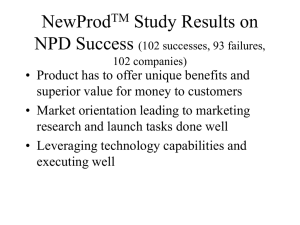
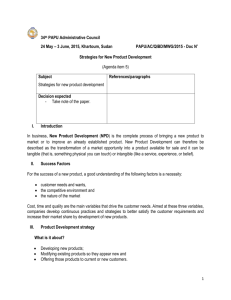
![Your [NPD Department, Education Department, etc.] celebrates](http://s3.studylib.net/store/data/006999280_1-c4853890b7f91ccbdba78c778c43c36b-300x300.png)
